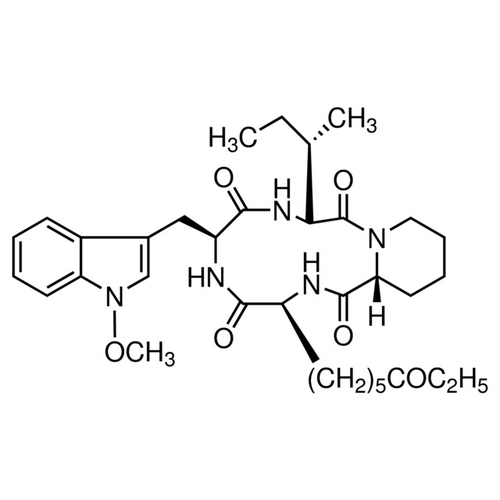| Product Name | Apicidin |
| Description |
HDAC inhibitor |
| Purity | >98% (HPLC); NMR (conforms) |
| CAS No. | 183506-66-3 |
| Molecular Formula | C34H49N5O6 |
| Molecular Weight | 623.8 |
| Field of Use | Not for use in humans. Not for use in diagnostics or therapeutics. For in vitro research use only. |
Properties
| Storage Temperature | -20ºC |
| Shipping Temperature | Shipped Ambient |
| Product Type | Inhibitor |
| Solubility | Soluble in 10 mg/ml DMSO or 100% Ethanol |
| Source | Synthetic |
| Appearance | White Solid |
| SMILES | CC[C@H](C)[C@H]1C(=O)N2CCCC[C@@H]2C(=O)N[C@H](C(=O)N[C@H](C(=O)N1)CC3=CN(C4=CC=CC=C43)OC)CCCCCC(=O)CC |
| InChI | InChI=1S/C34H49N5O6/c1-5-22(3)30-34(44)38-19-13-12-18-29(38)33(43)35-26(16-9-7-8-14-24(40)6-2)31(41)36-27(32(42)37-30)20-23-21-39(45-4)28-17-11-10-15-25(23)28/h10-11,15,17,21-22,26-27,29-30H,5-9,12-1 |
| InChIKey | JWOGUUIOCYMBPV-GMFLJSBRSA-N |
| Safety Phrases |
Classification: Toxic. May be harmful or fatal if inhaled, swallowed, or absorbed through skin. Safety Phrases: S22 - Do not breathe dust S36/37/39 - Wear suitable protective clothing, gloves and eye/face protection S24/25- Avoid contact with skin and eyes Hazard Statements: H300+H310 – Fatal if swallowed or in contact with skin. H330 – Fatal if inhaled Precautionary Statements: P260 – Do not breathe dust/fumes/gas/mist/vapours/spray P264- Wash hands thoroughly after handling P280 – Wear protective gloves/ Protective clothing P284 – Wear respiratory protection P302 + P350 – If on skin: Gently wash with plenty of soap and water. P310 – Immediately call a poison center or doctor/ physician |
| Cite This Product | Apicidin (StressMarq Biosciences Inc., Victoria BC CANADA, Catalog # SIH-346) |
Biological Description
| Alternative Names | (3S,6S,9S,15aR)-9-[(2S)-2-Butanyl]-6-[(1-methoxy-1H-indol-3-yl)methyl]-3-(6-oxooctyl)octahydro-2H-pyrido[1,2-a][1,4,7,10]tetraazacyclododecine-1,4,7,10(3H,12H)-tetrone; Cyclo(N-O-methyl-L-tryptophanyl-L Lisoleucinyl-Dpipecolinyl-L-2-amino-8-oxodecanoyl) |
| Research Areas | Cancer, Cell Signaling |
| PubChem ID | 6918328 |
| Scientific Background | Apicidin is a cyclopeptide inhibitor of histone deacetylases (HDACs), known for its ability to induce transcriptional activation and inhibit cell proliferation. While it has been primarily studied in oncology for its antiproliferative effects, Apicidin’s role in epigenetic modulation has implications for neuroscience. HDAC inhibitors like Apicidin are being explored for their potential to enhance synaptic plasticity, memory formation, and neuroprotection. By altering chromatin structure and gene expression, Apicidin may influence pathways involved in neurodegenerative diseases such as Alzheimer’s and Huntington’s. Its ability to decrease HIF1α protein levels and modulate transcriptional activity further supports its relevance in cellular stress responses, making it a candidate for broader neurological research. |
| References |
1. Darkin-Rattray S.J., et al. (1996) Proc. Natl. Acad. Sci. USA. 93: 13143. 2. Han J.W., et al. (2000) Cancer Res. 60: 6068. 3. Kim S.H., et al. (2007) Oncol. Rep. 17: 647. |



Reviews
There are no reviews yet.